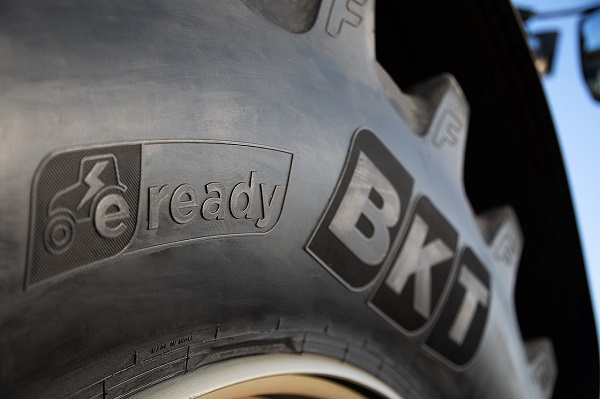The logo that officially kicks off the BKT tire family specifically tailored for electric vehicles was unveiled just a few weeks ago.
E-READY made its debut at SIMA, where we first saw it imprinted on the AGRIMAXFACTOR tire (BKT’s all-new 70 series designed for tractors), though it will be extended to all products in this category in the future.
E-READY specification represents a breakthrough, the beginning of a path toward delivering solutions suitable for electric mobility. It also aims to underscore BKT’s commitment to sustainability, a goal toward which every responsible business must direct research and investment. By stylizing the new logo, BKT seeks to showcase its aptitude for anticipating market needs through the robustness of its advanced technology.
However, was this breakthrough necessary? How does a tire intended for an electric vehicle differ from a conventional one?
There are many differences. In fact, trials and field tests have revealed that, in order to equip an electric vehicle, designers will have to take into account various factors that characterize electric mobility: weight, engine structure, range, noise.
Electric vehicles weigh more because their batteries may be adding up to 30% extra weight, something that really affects the work of the tire.
Not only are they heavier, they also move differently than vehicles running on natural gas or gasoline: the vehicle immediately hits maximum power when stepping on the accelerator. This means that load shifts can be faster and more intense than in conventional vehicles, with a consequent effect on tire wear.
Energy autonomy also plays a decisive role. If an electric vehicle is designed for energy savings, tires should also be designed not to affect vehicle consumption, such as the case of rolling resistant tires.
Last but not least, manufacturers are investing heavily on research in vehicle/tire consistency, even in terms of noise.
That’s why designing and developing tires suitable for electric mobility takes a specific path that differs from combustion vehicles.
Let’s explore the characteristics of tires designed for electric vehicles in greater detail.
Weights and sizes
As mentioned, electric vehicle tires bear a heavier weight of the vehicle they are equipping, since batteries can increase the weight of a vehicle by as much as 20-30% more than a conventional vehicle. This calls for greater stress resistance and thus a more robust structure, starting with reinforced belts and casing, to a different and specific sidewall and bead design.
Electric motors
A few additional differences that distinguish an electric vehicle tire from a conventional one include the ability to “withstand” higher drive torque, especially at the start. In fact, the electric motor gives more thrust to the mechanical transmission, and thus to the wheels, than a conventional vehicle, resulting in greater acceleration. This means that it is absolutely necessary to revisit the tire’s bead structure to ensure better grip on the rim, especially during acceleration. The tread must also be optimized, both in terms of design and compound.
Electrically powered vehicles have significantly more tire wear than combustion engine vehicles, which is why a different design is needed to ensure an optimal life cycle.
Autonomy
If the tires mounted on an electric vehicle are inadequate, they can cause significant energy losses, since rolling resistance can contribute as much as 20 percent of the vehicle’s energy consumption. In order to adjust the rolling resistance for electric vehicle tires, without compromising any other performance features, it is necessary to adapt the tread compound, tread pattern, and also the particular sidewall structure. The most suitable tire for electric vehicles will therefore be the one that is metaphorically less energy intensive. In other words, one whose advanced structure will not affect the electric vehicle’s range.
Noise
Noise is also something that tire manufacturers are particularly considering for electric vehicles, whose tires should have different tread patterns and compound compositions, both natural and synthetic. Size also significantly contributes to a tire’s quietness.
Thanks to its team of specialized researchers, BKT has developed the best solutions for the electric vehicle market through testing and prototyping. And that’s how the market came to know BKT’s first E-READY tire: AGRIMAXFACTOR, a new product designed for both transportation and tillage operations, full of distinctive and innovative features that make it a masterpiece of technology and aesthetic design. Its high-performance features include a technically improved tread pattern for better rideability and smoother impact on the road.
BKT is now also beginning to invest heavily in the e-mobility tire segment. While the center of gravity of the goals may shift, innovation and a wide range remain the beacons guiding BKT into the future.
Also Read
9 things to consider when choosing agricultural tire
Continental Tyre’s road to sustainability
